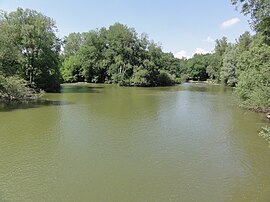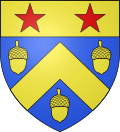Balham, Ardennes
Balham | |
|---|---|
 The Aisne at Balham | |
| Coordinates: 49°29′34″N 4°09′40″E / 49.4928°N 4.1611°E | |
| Country | France |
| Region | Grand Est |
| Department | Ardennes |
| Arrondissement | Rethel |
| Canton | Château-Porcien |
| Intercommunality | Pays Rethélois |
| Government | |
| • Mayor (2008–2020) | Vincent Roland |
| Area 1 | 1.77 km2 (0.68 sq mi) |
| Population (2010) | 135 |
| • Density | 76/km2 (200/sq mi) |
| Time zone | UTC+01:00 (CET) |
| • Summer (DST) | UTC+02:00 (CEST) |
| INSEE/Postal code | 08044 /08190 |
| Elevation | 71 m (233 ft) |
| 1 French Land Register data, which excludes lakes, ponds, glaciers > 1 km2 (0.386 sq mi or 247 acres) and river estuaries. | |
Balham is a commune in the Ardennes department in the Grand Est region of northern France.
The inhabitants of the commune are known as Balhamais or Balhamaises.[1]
The commune has been awarded one flower by the National Council of Towns and Villages in Bloom in the Competition of cities and villages in Bloom.[2]
Geography
Balham is located some 12 km west by south-west of Rethel and 3 km north-east of Asfeld. Access to the commune is by the D926 road from Gomont in the north-east which passes through the village and continues south-west to Asfeld. The commune is mixed forest and farmland.[3]
The Aisne river passes through the centre of the commune flowing from north-east to south-west on its way to join the Oise at Compiègne. The parallel Canal des Ardennes passes through the southern tip of the commune.[3]
Neighbouring communes and villages[3]
Toponymy
The name Balham comes from the name of a person Ballo + Heim. It was Balaan around 1172 and Balehan in 1211-1212.
Heraldry
 |
Blazon: Azure, a chevron of Or between three acorns the same, in chief also Or charged with two mullets of Gules.
|
Administration

| From | To | Name | Party | Position |
|---|---|---|---|---|
| 1995 | 2008 | Jean-Pierre Moraux | ||
| 2008 | 2020 | Vincent Roland |
(Not all data is known)
Demography
In 2010 the commune had 135 inhabitants. The evolution of the number of inhabitants is known from the population censuses conducted in the commune since 1793. From the 21st century, a census of communes with fewer than 10,000 inhabitants is held every five years, unlike larger communes that have a sample survey every year.[Note 1]
Template:Table Population Town



Sites and monuments

- The Cemetery (15th century)
 is registered as an historical monument.[5]
is registered as an historical monument.[5] - The Church of Saint John the Baptist contains several items that are registered as historical objects:
- A Stained glass window (1536)
 [6]
[6] - A Statue: Saint Barbe (15th century)
 [7]
[7] - A Statue: Saint Catherine (15th century)
 [8]
[8]
- A Stained glass window (1536)
Notable people linked to the commune
- Edmond Louis Alexis Dubois-Crancé (1747-1814), Revolutionary politician, member of the Committee of Public Order, General of the Republic, Commissioner of the Army and Minister of War (September–November 1799), became Mayor of Balham after 1800.
See also
External links
- Balham on the old National Geographic Institute website[permanent dead link] Template:Fr icon
- Balham on Lion1906
- Balham on Google Maps
- Balham on Géoportail, National Geographic Institute (IGN) website Template:Fr icon
- Balham on the 1750 Cassini Map
- Balham on the INSEE website Template:Fr icon
- INSEE Template:Fr icon
Notes and references
Notes
- ^ At the beginning of the 21st century, the methods of identification have been modified by Law No. 2002-276 of 27 February 2002 Archived 6 March 2016 at the Wayback Machine, the so-called "law of local democracy" and in particular Title V "census operations" allows, after a transitional period running from 2004 to 2008, the annual publication of the legal population of the different French administrative districts. For communes with a population greater than 10,000 inhabitants, a sample survey is conducted annually, the entire territory of these communes is taken into account at the end of the period of five years. The first "legal population" after 1999 under this new law came into force on 1 January 2009 and was based on the census of 2006.
References
- ^ Inhabitants of Ardennes Template:Fr icon
- ^ Balham in the Competition for Towns and Villages in Bloom Archived December 10, 2014, at the Wayback Machine Template:Fr icon
- ^ a b c Google Maps
- ^ List of Mayors of France Template:Fr icon
- ^ Ministry of Culture, Mérimée PA00078339 Cemetery Template:Fr icon
- ^ Ministry of Culture, Palissy PM08000045 IM08000079 Stained glass window (Bay 0) Template:Fr icon
- ^ Ministry of Culture, Palissy PM08000047 Statue: Saint Barbe Template:Fr icon

- ^ Ministry of Culture, Palissy PM08000046 Statue: Saint Catherine Template:Fr icon





